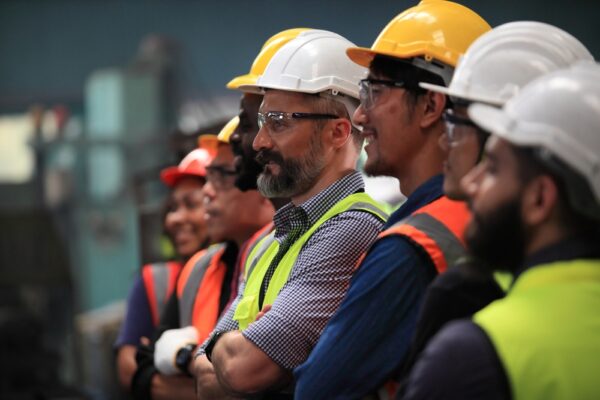
The maintenance technician shortage is neither new nor a problem that is easy to solve. Over the last few decades, a variety of challenges have hindered the industry’s ability to hire and retain skilled maintenance staff. While the gap between demand and supply of qualified technicians continues to grow, there are practical steps organizations can take to address the issue. In this article, we explore why the technician shortage exists and what you can do about it.
The State of the Maintenance Technician Workforce
The United States Bureau of Labor Statistics (BLS) projects that the general maintenance and repair worker job market is expected to increase by 4% over the next 10 years, with an estimated 159,800 openings per year. The largest employers for these positions are concentrated in property maintenance, as well as industries such as:
- Real estate
- Government and public administration
- Manufacturing
- Healthcare facilities maintenance
- Educational services
Skilled maintenance technicians are needed to maintain, improve, and renovate buildings and structures – especially older ones with more complex, frequent, and costly repairs. Although the BLS projects modest growth in maintenance jobs, the number of available skilled technicians has not kept pace with industry demand. Understanding the technician shortage requires a closer look at forces influencing today’s workforce.
Why Maintenance Technicians Are in Short Supply

The maintenance technician shortage didn’t happen overnight. Industry warnings about a potential gap in skilled labor have surfaced periodically over the last two decades, but the issue became more noticeable as Baby Boomers started retiring in the 2010s.
This wave of retirements, combined with other generational, societal, and economic factors, has made it more difficult for organizations to attract and retain qualified maintenance staff. The following sections explore the main causes of today’s technician shortage.
Retiring Technicians Outnumber New Hires
One major reason for the maintenance technician shortage is that more seasoned veterans are retiring than there are new, entry-level workers entering the labor market. As noted by the BLS, many openings are “expected to result from the need to replace workers who transfer to different occupations or exit the labor force, such as to retire.”
According to its 2024 Transportation Technician Supply & Demand Report, TechForce Foundation, a national non-profit committed to workforce development for professional technicians, found that nearly 1,000,000 new-entry level technicians will be needed over the next 5 years. Further, it states that in some sectors, “replacement needs outpace workforce growth at a rate of more than 4-to-1.”
While some skilled technicians change careers, the TechForce findings and BLS projections indicate that the surge in retirements among Baby Boomers is a key driver of today’s maintenance technician shortage. These experienced workers are leaving faster than they can be replaced, taking years of knowledge and experience with them.
Fewer Younger Workers Choosing Maintenance Careers
The post-World War II era in the United States was a period of rapid economic growth, rising white-collar employment, and expanded access to higher education. As automation began to change manufacturing and skilled labor jobs, many families came to view a 4-year college degree as offering better lifetime earnings and greater job stability than trade careers. These perceptions were passed on to the next generation and continue to influence career choices today.
Over time, these cultural attitudes also shaped the education system. Schools placed more emphasis on college preparedness than on hands-on career and technical education (CTE). A Modern Machine Shop article suggests the No Child Left Behind Act contributed to the disappearance of shop classes from many schools in the 2000s and 2010s. As a result, many students are unaware of potential careers in the trades and the talent pipeline has shrunk.
Industry experts also note other contributors to low interest in maintenance careers, including inadequate support or incentives for training programs, limited apprenticeship opportunities, outdated work environments, and skills gaps exacerbated by the COVID-19 pandemic.
Skills Gap Among New Technicians
As the older generation leaves the workforce, they take with them years of experience and specialized skills that are not easily replaced by new technicians. Much maintenance work also relies on undocumented tribal knowledge that can only be gained through hands-on experience with an organization’s assets over time.
Rapidly changing technology, including automation, the Industrial Internet of Things (IIoT), predictive maintenance, and artificial intelligence (AI), requires today’s technicians to possess a diversified skill set beyond traditional manual maintenance skills. Combined with limited training opportunities and the fast pace of new technologies, many new technicians lack the hands-on experience or technical knowledge needed to be efficient and productive.
A 2022 Advanced Technology Services report found that 32% of organizations surveyed outsource maintenance labor because skilled individuals are hard to find.
Tight Budgets Limiting Hiring and Retention
Budget constraints are a significant factor contributing to the maintenance technician shortage. Many maintenance roles offer lower wages compared to other technical or skilled positions, making it difficult to attract and retain top talent. Even when organizations recognize the need for more qualified maintenance staff, tight budgets can force them to delay hiring, leave positions unfilled, or hire fewer employees than needed.
Financial pressures also affect training and career development opportunities. Limited funding for onboarding, certifications, apprenticeships, and other professional development can make maintenance careers less appealing, especially for younger workers.
Limited budgets often mean maintenance departments can’t improve working conditions or offer competitive incentives. Outdated equipment, safety hazards, long shifts, and minimal professional development opportunities can discourage skilled technicians from joining or staying with the organization.
Organizational Barriers
The maintenance technician shortage is not just about incoming hires – it is also influenced by how organizational dynamics affect current workers in the field. Because the maintenance department is traditionally viewed as a cost center, maintenance managers and technicians commonly feel overlooked or undervalued by executive leadership, which can hurt employee morale, retention, and overall productivity.
When executives do not fully appreciate the critical role maintenance plays in asset reliability, decisions about staffing, budgets, and training may not align with real maintenance needs. Organizations may cut back on preventive or proactive maintenance, leading to more reactive work orders, unexpected equipment failures, and deferred maintenance. These conditions increase stress on the maintenance team, reduce job satisfaction, and can contribute to higher turnover.
Addressing the Maintenance Technician Shortage

Just as the maintenance technician shortage didn’t appear overnight, it cannot be quickly solved either. By understanding the underlying causes for the lack of qualified maintenance employees, organizations can work to proactively address the issue on multiple fronts. Some solutions require long-term investments or thinking outside the box, others can produce short-term results.
By combining both immediate and strategic approaches, organizations can strengthen their maintenance workforce, improve retention, and reduce the impact of the technician shortage over time. Below are several strategies to consider.
Attracting and Hiring New Maintenance Technicians
Despite the shortage of maintenance technicians, they are still in great demand. Consider the following strategies to identify and recruit qualified candidates.
Expand Talent Pipelines
To overcome the technician shortage, organizations must look beyond traditional hiring practices and tap into a broader range of talent sources. Expanding the pipeline ensures that both new and experienced workers have opportunities to enter the field and contribute their skills.
Establishing a relationship with local schools and vocational programs can help build your employee pipeline, ensuring that there is a steady flow of candidates. Investing in students early brings awareness to careers in maintenance and can help bridge the skills gap before entering the workforce. Talk to your organization about offering internships or apprenticeships to students.
Another way to expand your pipeline is by engaging retirees. Senior technicians often hold decades of practical knowledge about equipment and processes. Interviewing them before they leave, or offering part-time or consulting roles, helps capture this knowledge and allows it to be passed on to newer hires.
Organizations can also look to veterans as a valuable talent pool. Many veterans possess strong technical skills and experience with structured maintenance practices gained during their military service. Recruiting from this group not only strengthens your workforce but also supports individuals transitioning into civilian careers.
Many organizations also utilize outsourced and on-demand maintenance labor to temporarily fill vacant positions or for maintenance work that requires specialized skills.
Use Modern Maintenance Technology
A workplace that uses modern technology can be a strong motivator for tech-savvy candidates. Younger generations entering the workforce grew up in the digital age and are naturally more comfortable using software, apps, and connected devices. They expect the tools they use on the job to reflect the same level of efficiency and usability they experience in their everyday lives. Organizations that still rely on paper or spreadsheets for maintenance tracking may risk appearing outdated to this group.
Implementing a computerized maintenance management system (CMMS) not only improves productivity and efficiency for your team, but also demonstrates a commitment to giving employees the right tools to succeed.
Provide Competitive Work Environment
Younger workers may look for workplaces where they can learn new skills, collaborate with others, and feel a sense of purpose in their work. Demonstrating a modern, well-organized maintenance culture can help set your organization apart in a competitive labor market and make your open positions more attractive to top candidates.
While factors like compensation and benefits may be out of your hands, you can still foster a supportive, engaging environment where employees feel valued, mentored, and connected to the work they do.
Leverage Skills-based Recruiting
Given the challenges of attracting new talent, organizations need to look beyond traditional hiring practices. While past experience is valuable, today’s candidates do not have the same practical experience as generations past.
Skills-based recruiting focuses on a candidate’s attention to detail, judgment, problem-solving skills, digital literacy, and other essential skills, rather than past experience. Evaluating candidates this way helps organizations reach a more diverse set of employees who are ready to contribute, even if they lack practical, hands-on experience.
Training Your Team
Developing a skilled maintenance workforce requires meaningful investment in your employees. Providing opportunities for training, professional development, and mentorship not only improves technical capabilities but also strengthens retention and job satisfaction. Below are several ways organizations can support and grow their maintenance teams.
Invest in Technical Training
Ongoing technical training is critical because maintenance technology and equipment are constantly evolving. Organizations should offer programs for both new hires and existing staff to ensure their skills remain up to date. This can include onsite consulting and training services, as well as hands-on experience with CMMS software and other maintenance technology.
Training programs not only enhance efficiency and effectiveness but can also make maintenance careers more appealing to younger workers entering the field.
Explore best practices to increase CMMS user adoption
Provide Resources for Completing Certifications
Certifications help maintenance technicians validate and expand their expertise, making them more capable and marketable. Employers can support employee certification by offering paid training time, tuition assistance, and other resources. Common certification programs for maintenance professionals include:
- Certified Maintenance and Reliability Technician (CMRT)
- Certified Maintenance and Reliability Professional (CMRP)
- Certified Facility Manager (CFM)
- Certified Plant Engineer (CPE)
Industry-specific programs, such as automotive service technician certifications offered through organizations like the National Institute for Automotive Service Excellence (ASE), can further enhance skills that are relevant to your industry or organization.
Use a CMMS for Skills Development
A computerized maintenance management system (CMMS) not only makes operations more efficient, but can also serve as a platform for computer skill development. By using the software to manage work orders, track inventory, and analyze maintenance data, new hires and experienced staff can develop essential technical and analytical skills.
Learning to navigate a CMMS can also make it easier to adopt other workplace technologies, such as digital tools for reporting, basic diagnostics, or simple condition-monitoring devices.
Leverage Retiree Knowledge Through Mentorship
Establishing mentorship programs with retirees or seasoned technicians allows them to share their expertise and transfer their knowledge to newer employees. This can include formal training sessions, shadowing opportunities, or even consulting arrangements where retirees provide guidance on complex equipment and processes.
Pairing experienced staff with new hires helps preserve knowledge, maintains continuity in maintenance practices, and quickly develops younger technicians as they acclimate to their roles.
Reducing Turnover
Keeping skilled maintenance technicians is just as important as attracting them. High turnover can exacerbate the technician shortage, reduce productivity, and increase operational risk. While maintenance leaders may not have total control over retention, they can advocate for their employees and help influence decisions that encourage staff to stay. Consider the following retention strategies.
Build a Strong Maintenance Culture
A positive maintenance culture ensures that technicians feel valued, supported, and engaged. When maintenance is recognized as a critical business function rather than a cost center, employees are more likely to stay.
Maintenance leadership can also do their part to encourage open communication, provide mentorship, collaborate across teams, and recognize contributions to reliability and operational success. This strong workplace culture helps build loyalty and reinforces the organization’s commitment to its maintenance workforce.
Offer Ongoing Professional Development
Providing opportunities for skill growth and career advancement keeps technicians motivated and engaged. This can include access to technical training programs, support for certifications, and cross-training in different systems or equipment. Ongoing development not only improves performance but also demonstrates that the organization is invested in employees’ long-term careers.
Streamline Work and Improve Job Satisfaction with a CMMS
When properly implemented, a CMMS can make technicians’ daily tasks more manageable and reduce operational frustrations. By providing a clear system for tracking maintenance, managing work orders, and locating spare parts, a CMMS helps staff stay organized and focus on their work. When technicians feel equipped with the right tools to do their job, it can improve morale, job satisfaction, and contribute to a more stable and committed workforce.
Address the Maintenance Technician Shortage with FTMaintenance Select
The maintenance technician shortage is causing headaches for many organizations, but there is hope. By understanding the underlying causes of the technician shortage and applying the strategies outlined in this article, organizations can take meaningful steps to strengthen their maintenance workforce.
Tools like FTMaintenance Select make it easier to implement these strategies by streamlining workflows, supporting professional development, and improving daily operations, helping teams attract, train, and retain skilled technicians in a challenging labor market. Request a demo of FTMaintenance Select today to see how you can address the technician shortage head-on while empowering your team to work smarter and more effectively.